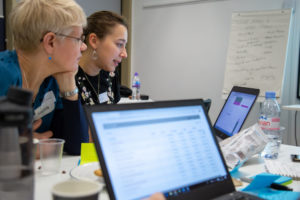Telling tales with data
We usually associate data as numbers. Scary words like average, mean and percentages are thrown into the air. Numbers are important to us, but the human brain cannot easily grasp large numbers and we are bombarded by figures and ‘facts’.
 To bring clarity and meaning to what we find in data and why it’s important, we need to use stories. This is why presenting the data through storytelling is an integral part of the data pipeline.
To bring clarity and meaning to what we find in data and why it’s important, we need to use stories. This is why presenting the data through storytelling is an integral part of the data pipeline.
However, storytelling is an art of its own – creating good plots with twists and conflicts that resolve at the end into something inspiring for those who wish to inform or influence.
So how can we make numbers interesting and relatable?
We have been thinking about this a lot here at 360Giving. We run ‘questions workshops’ which help people think more specifically about the questions they can ask of their data. Having clarity on the questions you want to ask and what’s possible to discover from a particular dataset helps when the time comes to do the data analysis.
But what do you do once you have findings? How can you bring them to life?
After reading some useful reports about storytelling like The Story Behind the Story (by Jed Miller and Alison Miranda) and listening to the BBC podcast The Tyranny of Story, we created together with FabRiders a workshop format that aims to make you a better data-storyteller!
We trialled this approach at our Data Surgery in December 2018 with 20 grantmakers.
Here are some of our learnings:
- Storytelling basics first, then data – even if you’ve read thousands of stories, it’s always good to go back to basics and remind ourselves what makes a good story. In short – a story has human elements, is relatable and re-tellable, has a conflict or a challenge and a protagonist who tries to resolve it.
- Tailor the story to your audience – people are different and react to stories in different ways. We took a user-centred design approach to get to know our audience and what stories can lead them to action by creating a character sheet.
- Be data responsible – sometimes the findings from the data analysis won’t fit the narrative you want to tell. Be responsible and don’t manipulate the data to fit it. Either talk about the data and change the narrative, or don’t talk about it.
- Use visuals – visuals can be a great aid when telling complex data stories. Use them to expand on a complex point or even as a starting point to help understand data better.
- Practice and get feedback – it takes a while to master the art of storytelling with data. Don’t be afraid to write something short and get feedback from a colleague. Gradually your confidence and storytelling skills will grow!
Story time
For inspiration, check out these grantmaker data stories, where Lloyds Bank Foundation lets data take the wheel and Youth Music looks at investment in music in deprived areas.
We are going to run more workshops about storytelling with data in 2019 as part of our regular Data Surgeries. The first one will be in Manchester on 14th March. You can sign up for it here.
If you have data and want to learn how you can tell a meaningful story for grantmakers, or you have examples of stories you’d like to share with us, please send an email to labs@threesixtygiving.org
